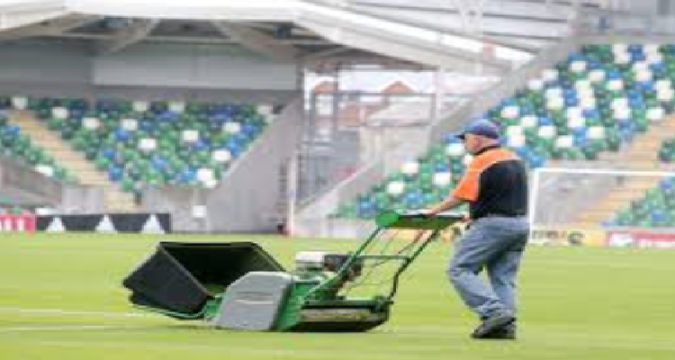
Maintaining your club’s home field in the best possible condition is essential to creating an environment where players perform at their peak and fans enjoy an exceptional experience. A well-kept stadium demonstrates professionalism, dedication, and respect for both the sport and those who come to enjoy it. Regular and comprehensive maintenance goes a long way in ensuring the longevity and appeal of the stadium, preserving it as a place where memories are made. Here are some crucial stadium maintenance practices that can help keep your home field in top form.
1. Prioritizing Pitch Health and Turf Care
The quality of the pitch is critical to both gameplay and player safety. A healthy field requires a rigorous maintenance plan, including mowing, watering, aeration, fertilization, and pest control. Grass pitches are generally preferred for their natural feel, but they demand more care than synthetic turf. Groundskeepers should maintain a routine schedule for mowing and watering the field, adjusting it based on the season, weather, and grass growth rate.
To keep the pitch resilient, aeration should be carried out regularly, as it allows air, water, and nutrients to reach the roots. This process prevents soil compaction and promotes healthy grass growth, resulting in a more durable playing surface. Additionally, modern stadiums often use high-tech irrigation systems that provide the right amount of water, optimizing moisture levels without wastage. Synthetic fields also require regular maintenance, including brushing and leveling to maintain an even, safe playing surface.
2. Ensuring Comprehensive Seating Maintenance
Fans’ comfort is a vital aspect of their stadium experience, making seat maintenance a priority. Seats can quickly become worn due to regular use and exposure to weather elements, especially in outdoor stadiums. Regular inspections are crucial to check for loose bolts, damaged seats, and any safety hazards. If any seating issues are identified, immediate repairs or replacements should be made to avoid potential injuries and ensure fans’ comfort.
Stadiums can also benefit from upgrading seating materials. For instance, UV-resistant seats or those with a protective coating can withstand harsh sunlight and reduce fading, extending their lifespan. Cleaning seats after every event is equally important, not only to maintain a clean appearance but also to prevent dirt buildup that can damage materials over time.
3. Establishing a High Standard of Cleanliness
Cleanliness is an indispensable component of stadium maintenance. With thousands of fans attending events, maintaining a spotless environment involves thorough planning and efficient waste management. Concession stands, bathrooms, seating areas, and concourses must be kept clean to ensure the comfort and health of attendees.
A robust waste management program is vital, with plenty of recycling and waste bins strategically placed throughout the stadium. This not only promotes cleanliness but also contributes to a sustainable stadium environment. Deep cleaning should be carried out after each event, including power-washing floors, disinfecting restrooms, and sanitizing commonly touched surfaces. This helps prevent pest infestations, eliminates odors, and leaves the stadium fresh for the next event.
4. Maintaining Lighting and Audio-Visual Systems
Proper lighting and audio-visual equipment are essential for creating an immersive game-day experience. Stadiums typically use powerful lights to illuminate the field during night games, so it’s vital to maintain these lighting systems regularly. This includes replacing burnt-out bulbs, checking fixtures, and ensuring backup power options are in place.
Upgrading to LED lighting can be beneficial for many stadiums, as it provides better illumination and is more energy-efficient. Audio systems, scoreboards, and large screens should also be checked frequently to ensure clear and reliable sound and visuals. Any maintenance issues with these systems should be addressed promptly to prevent disruptions during games.
5. Structural Inspections and Repairs
Safety should always come first, and stadiums must undergo routine structural inspections to identify and address any issues that could pose a risk to fans and staff. Inspecting structural components such as beams, railings, stairs, and walls helps ensure the building remains stable and secure. A professional assessment should be conducted periodically to check for signs of wear, cracks, or corrosion.
If any structural damage is detected, it’s critical to make repairs immediately. Preventative measures like waterproofing, sealing cracks, and applying rust-resistant coatings can also extend the lifespan of structural elements and help avoid costly repairs down the road.
6. Investing in Advanced Security Systems and Emergency Preparedness
A safe stadium is essential for a positive fan experience, and modern technology can help achieve this. Installing advanced security systems, including surveillance cameras and alarm systems, helps monitor crowd movement and deter any potential security threats. Regular maintenance and testing of security equipment are necessary to ensure these systems work efficiently when needed.
In addition to security, staff should be trained for emergency preparedness. This includes conducting regular drills for scenarios like fire, medical emergencies, and evacuation procedures. An effective emergency plan not only keeps fans safe but also builds confidence in the club’s commitment to their well-being.
7. Implementing Sustainable Practices
Sustainability is increasingly important in stadium management. Incorporating eco-friendly practices, such as recycling programs, energy-efficient lighting, and water conservation systems, contributes to the environment while potentially reducing operating costs. Installing rainwater harvesting systems for irrigation, using solar power, and reducing single-use plastics at concession stands are effective ways to make the stadium more sustainable.
Many fans appreciate and support sustainability efforts, and promoting these practices can improve the club’s image and build a loyal fan base.
Conclusion
Maintaining the best possible condition of a football club’s home field requires commitment, organization, and investment in proper maintenance practices. By focusing on key areas—such as pitch health, seating, cleanliness, lighting, structural integrity, and sustainability—stadiums can provide a safe, enjoyable, and lasting experience for both players and fans. Embracing regular maintenance routines not only preserves the quality of the stadium but also reflects the club’s dedication to excellence, helping it remain a beloved and iconic home ground.